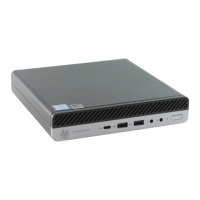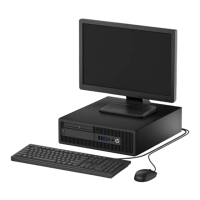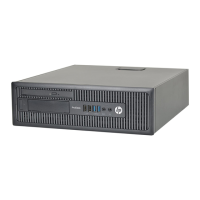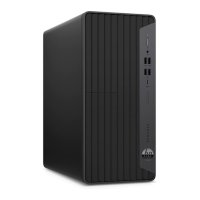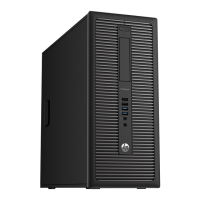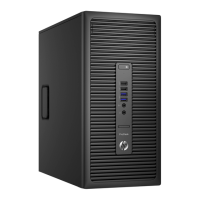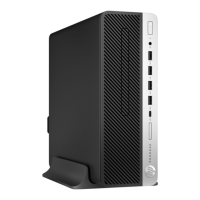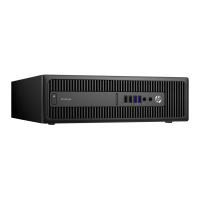Do you have a question about the HP ProDesk 600 G3 and is the answer not in the manual?
Describes the basic setup and capabilities of the computer model.
Identifies and explains the ports and controls on the front of the computer.
Details the ports and connectors located on the back of the computer.
Explains where to find the unique serial and product ID numbers for the computer.
Explains the meaning of WARNING, CAUTION, and NOTE indicators used in the manual.
Lists and illustrates the main internal hardware components of the computer.
Shows various smaller, miscellaneous parts and accessories for the computer.
Illustrates and identifies different types of cables and adapters used with the computer.
Lists various hard drive and optical drive options available for the computer.
Details various expansion cards, system boards, and other modules.
Provides essential precautions to prevent damage from static electricity.
Offers advice on how to operate the computer to prevent overheating and prolong its life.
Gives instructions for cleaning the computer case, keyboard, monitor, and mouse.
Outlines important points to keep in mind during disassembly and assembly.
Offers best practices for managing cables inside the computer.
Outlines initial safety procedures and steps before opening the computer.
Details the procedure for removing and installing the computer's access panel.
Explains how to remove and replace the front bezel of the computer.
Details the procedure for removing and installing the computer's drive cage.
Provides step-by-step instructions for installing RAM modules into the motherboard.
Guides on removing, replacing, or adding PCI Express expansion cards.
Lists various drive types and guidelines for their removal and installation.
Explains removal and installation of the processor and its cooling system.
Details the procedure for removing and replacing the computer's power supply unit.
Details the procedure for removing and installing the system board.
Lists the functions that can be performed using the Computer Setup utility.
Provides steps on how to access and navigate the Computer Setup utility menu.
Covers system information, BIOS settings, and system diagnostics within the utility.
Details password settings, security configurations, and TPM options.
Explains advanced settings related to display, boot options, and system configuration.
Explains how to save and restore BIOS settings using removable media.
Discusses safe work environment practices and potential hazards.
Offers preliminary steps to isolate problems before contacting support.
Provides general suggestions for resolving common computer issues.
Addresses common issues like system lock-ups, date/time errors, and poor performance.
Details solutions for issues related to power supply and automatic shutdowns.
Covers troubleshooting for hard disk errors, data access, and boot issues.
Provides solutions for blank screens, resolution issues, and image quality problems.
Offers help for sound issues, including no sound or muffled audio.
Offers solutions for network connectivity issues and driver problems.
Addresses issues related to insufficient memory or incorrect module installation.
Covers issues like application errors and incorrect configuration.
Lists POST error codes and messages with recommended actions for resolution.
Explains how to interpret system status indicators and beep codes.
Details how to clear system passwords by resetting the password jumper.
Explains how to reset BIOS settings to factory defaults using the CMOS button.
Guides on how to download diagnostic tools to a USB drive for system testing.
Provides information on creating backups and system recovery in Windows 10.
Explains how to create recovery media for specific HP computer models.
Describes tools and methods for restoring the computer to a working state.
Explains how to use Windows tools for file recovery and system restore.
Details the steps for safely replacing the computer's internal battery.
Details how nonvolatile memory types are used and protected within the system.
Lists requirements for power cords applicable to all countries.
Specifies the power cord requirements for use in Japan.
Provides physical dimensions and weight specifications for the computer chassis.
Lists the acceptable operating temperature and humidity levels for the computer.
Lists operating voltage, rated voltage, and line frequency for the power supply.
Describes the basic setup and capabilities of the computer model.
Identifies and explains the ports and controls on the front of the computer.
Details the ports and connectors located on the back of the computer.
Explains where to find the unique serial and product ID numbers for the computer.
Explains the meaning of WARNING, CAUTION, and NOTE indicators used in the manual.
Lists and illustrates the main internal hardware components of the computer.
Shows various smaller, miscellaneous parts and accessories for the computer.
Illustrates and identifies different types of cables and adapters used with the computer.
Lists various hard drive and optical drive options available for the computer.
Details various expansion cards, system boards, and other modules.
Provides essential precautions to prevent damage from static electricity.
Offers advice on how to operate the computer to prevent overheating and prolong its life.
Gives instructions for cleaning the computer case, keyboard, monitor, and mouse.
Outlines important points to keep in mind during disassembly and assembly.
Offers best practices for managing cables inside the computer.
Outlines initial safety procedures and steps before opening the computer.
Details the procedure for removing and installing the computer's access panel.
Explains how to remove and replace the front bezel of the computer.
Details the procedure for removing and installing the computer's drive cage.
Provides step-by-step instructions for installing RAM modules into the motherboard.
Guides on removing, replacing, or adding PCI Express expansion cards.
Lists various drive types and guidelines for their removal and installation.
Explains removal and installation of the processor and its cooling system.
Details the procedure for removing and replacing the computer's power supply unit.
Details the procedure for removing and installing the system board.
Lists the functions that can be performed using the Computer Setup utility.
Provides steps on how to access and navigate the Computer Setup utility menu.
Covers system information, BIOS settings, and system diagnostics within the utility.
Details password settings, security configurations, and TPM options.
Explains advanced settings related to display, boot options, and system configuration.
Explains how to save and restore BIOS settings using removable media.
Discusses safe work environment practices and potential hazards.
Offers preliminary steps to isolate problems before contacting support.
Provides general suggestions for resolving common computer issues.
Addresses common issues like system lock-ups, date/time errors, and poor performance.
Details solutions for issues related to power supply and automatic shutdowns.
Covers troubleshooting for hard disk errors, data access, and boot issues.
Provides solutions for blank screens, resolution issues, and image quality problems.
Offers help for sound issues, including no sound or muffled audio.
Offers solutions for network connectivity issues and driver problems.
Addresses issues related to insufficient memory or incorrect module installation.
Covers issues like application errors and incorrect configuration.
Lists POST error codes and messages with recommended actions for resolution.
Explains how to interpret system status indicators and beep codes.
Details how to clear system passwords by resetting the password jumper.
Explains how to reset BIOS settings to factory defaults using the CMOS button.
Guides on how to download diagnostic tools to a USB drive for system testing.
Provides information on creating backups and system recovery in Windows 10.
Explains how to create recovery media for specific HP computer models.
Describes tools and methods for restoring the computer to a working state.
Explains how to use Windows tools for file recovery and system restore.
Details the steps for safely replacing the computer's internal battery.
Details how nonvolatile memory types are used and protected within the system.
Lists requirements for power cords applicable to all countries.
Specifies the power cord requirements for use in Japan.
Provides physical dimensions and weight specifications for the computer chassis.
Lists the acceptable operating temperature and humidity levels for the computer.
Lists operating voltage, rated voltage, and line frequency for the power supply.
| Chipset | Intel Q270 |
|---|---|
| Processor | Intel Core i7, i5, i3 |
| RAM | Up to 64GB DDR4 |
| Graphics | Intel HD Graphics 630 |
| Operating System | Windows 10 Pro |
| Form Factor | Small Form Factor |
| Ports | USB 3.0, USB 2.0, DisplayPort, VGA |
| Network | Integrated Intel I219LM GbE |
| Weight | Varies by form factor |
| Storage | HDD, SSD, or hybrid drive options available |
| Dimensions | Varies by form factor |
